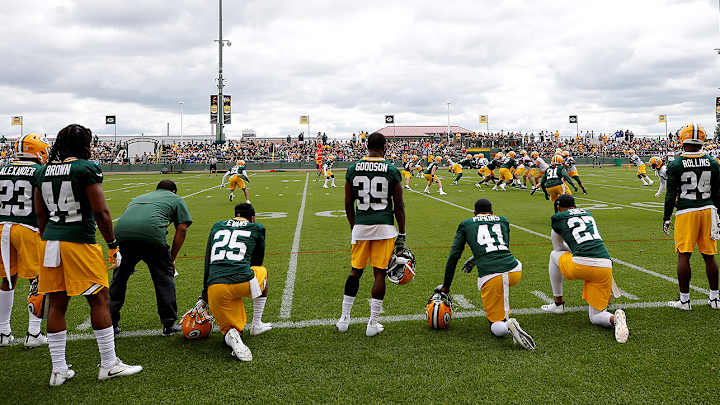Will Green Bay’s Young CBs Take the Defense to the Next Level? 10 Thoughts on the 2018 Packers

With the NFL season just a few weeks away, Andy Benoit is previewing every NFL team in reverse order of last season’s finish. Up today: the Green Bay Packers, who finished 7–9 in 2017.
1. The Packers, who haven’t had a defense finish in the top 10 since their 2010 Super Bowl season, hired former Jets defensive coordinator and Browns head coach Mike Pettine to lead the unit, but they’re taking a familiar schematic approach. Pettine, like retired predecessor Dom Capers, prefers perimeter man coverage and blitzing, which explains why new GM Brian Gutekunst used his first two draft picks on cornerbacks—Louisville’s Jaire Alexander and Iowa’s Josh Jackson—like his predecessor Ted Thompson did in 2015 with Damarious Randall and Quinten Rollins. Both rookies enter the pros with more defined styles than Randall (now a Brown) and Rollins (now a fringe backup) did. Alexander is an aggressive presser who also has the type of compact body that Pettine prefers in the slot; Jackson is a lanky perimeter stopper. Factor in last year’s intriguing second-rounder Kevin King and this is, perhaps, football’s most gifted young cornerbacking trio. Strong man-to-man coverage gives Pettine’s blitzes the best chance to succeed.
Green Bay has built a man coverage, blitz-oriented defense under two different coordinators and two different general managers. The common thread between those regimes is head coach Mike McCarthy. The Packers wouldn’t adopt a defensive foundation that their head coach doesn’t like, and as an offensive guy, McCarthy would presumably implement a defense against which he hates playing. Opponents should consider man coverage and blitzing when facing McCarthy’s offense.
2. Just like with smart phones, it’s important for systems in football to undergo updates. McCarthy talked early this offseason about taking Green Bay’s playbook “back to page one,” but don’t think you’ll see a whole new Packers offense. Almost every NFL system ultimately takes on the shape of its quarterback, especially with a superstar like Aaron Rodgers. Though capable of beating defenses with quick throws and shrewd presnap reads, Rodgers often prefers to go off-schedule and make plays outside of structure. He frequently passes up open receivers and leaves clean pocket, something that would warrant a reprimand for most quarterbacks. But Rodgers, the most physically gifted quarterback of all-time, often winds up making better plays when he follows his instincts. The tricky part: this unorthodox approach is more conducive to spread formations and isolation routes, partly why you don’t often see Green Bay employ presnap motion, switch releases and route combinations. McCarthy’s challenge is finding a happy medium. Iso routes might fit Rodgers, but if they’re relied upon too heavily, a passing game suffers dry spells.
• BREER: Aaron Rodgers and his quest to be a 40-year-old starting quarterback like Tom Brady
3. Those spread formations can be potent with flexible hybrid weapons like Ty Montgomery and especially Randall Cobb, who texturize McCarthy’s unusual but staple four- and five-receiver packages. It helps that perimeter wideouts Davante Adams and even the lanky Geronimo Allison can occasionally slide to slot.
4. Another flexible weapon is tight end Jimmy Graham, who signed for $30 million over three years in free agency. Three years with Russell Wilson makes Graham familiar with the sandlot style that Green Bay drills, and his size and post-up ability help fill the void in back-shoulder and red zone catches after Jordy Nelson’s departure.
5. A pressure-intensive defense is often only as good as its ability to stop the run—that’s what creates the obvious passing situations against which to blitz. Green Bay’s defensive line, led by tenacious playmaker Mike Daniels, is potentially one of the league’s best. Light-footed 2016 first-rounder Kenny Clark has shown immense talent, but only in flashes, and ex-Jet Muhammad Wilkerson hasn’t played up to his boundless ability since 2015.
6. Packer fans are always clamoring for upgrades at linebacker, but young mid-round linebackers must suffice when the team invests heavily in defensive linemen, cover corners and edge rushers like Clay Matthews ($11.4 million cap number in ’18) and Nick Perry ($10.75 million cap number). Blake Martinez and third-round rookie Oren Burks are proficient ball-hunters when those around them are playing well. Pettine’s system poses a unique challenge for linebackers. Instead of worrying about defending run gaps, Pettine implores his defensive linemen to just attack the man in front of them and create destruction, especially with penetration. The linebackers must read the play and find the ball, which leads to a lot of big plays ... if the D-line wins.
• Andy Benoit’s 2018 NFL Team Previews: Redskins | Bengals | Dolphins | Raiders | 49ers | More
7. Not all of Pettine’s blitzes are actually blitzes. Some involve a zone exchange, where a second-level defender blitzes while a first-level defender drops into coverage, creating a disguised four-man rush. Pettine makes his scheme look more complex than it really is by repeating these pressure concepts out of different personnel packages. For this to work, his safeties Ha Ha Clinton-Dix (in a contract year) and 2017 second-rounder Josh Jones must be versatile box players.
8. Rodgers wasn’t the only wounded Packer in 2017. Much of the offensive line, including agile stud left tackle David Bakhtiari, battled injuries. A healthy, continuous O-line makes Rodgers’s unique off-schedule style more feasible.
9. Montgomery and second-year pros Jamaal Williams and Aaron Jones are expected to rotate at running back. Stats can lie, but sometimes they’re too lopsided to ignore. These backs’ yards per carry last year: Montgomery 3.8; Williams 3.6; Jones 5.5. Jones has deft balance and short-area movement skills.
10. No matter how the playbook reads, expect slant routes, flat routes, trips receivers screens and back-shoulder throws to be major components of Green Bay’s offense.
